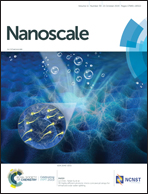Viral antigen nanoparticles for discriminated and quantitative detection of different subtypes of anti-virus immunoglobulins†
Abstract
The aim of this study is to develop a novel method for the accurate diagnosis of the infection status of viral diseases, which requires discriminated and quantitative detection of different anti-virus immunoglubulin subtypes. Considering hepatitis A as a representative model disease, viral antigen nanoparticles (vAgNPs) were designed and synthesized by genetically presenting hepatitis A virus (HAV) antigens on the surface of human heavy chain ferritin (hFTH) nanoparticles to detect anti-HAV antibodies with discriminating immunoglobulin subtypes M and G (IgM and IgG, respectively). The vAgNPs also display multi-copies of hexa-histidine peptide (H6) on their surface to chemisorb gold ions (Au3+), which is vital for the autonomous generation of quantitatively meaningful detection signals. The quantitative level of anti-HAV IgM or IgG in 30 patient sera was successfully analyzed using the vAgNPs of HAV, which was performed through label-free one-step-immunoassay based on the self-enhancement of optical signals from gold nanoparticles clustered on the viral antigen nanoparticles. The diagnostic performance was compared with that of enzyme-linked immunosorbent assay (ELISA), which did not enable accurate quantitative assay due to the poor linearity between the antibody concentration and detection signal. Furthermore, these vAgNP-based immunoassays did not produce any false negative/positive signals, indicating 100% sensitivity and 100% specificity.



 Please wait while we load your content...
Please wait while we load your content...